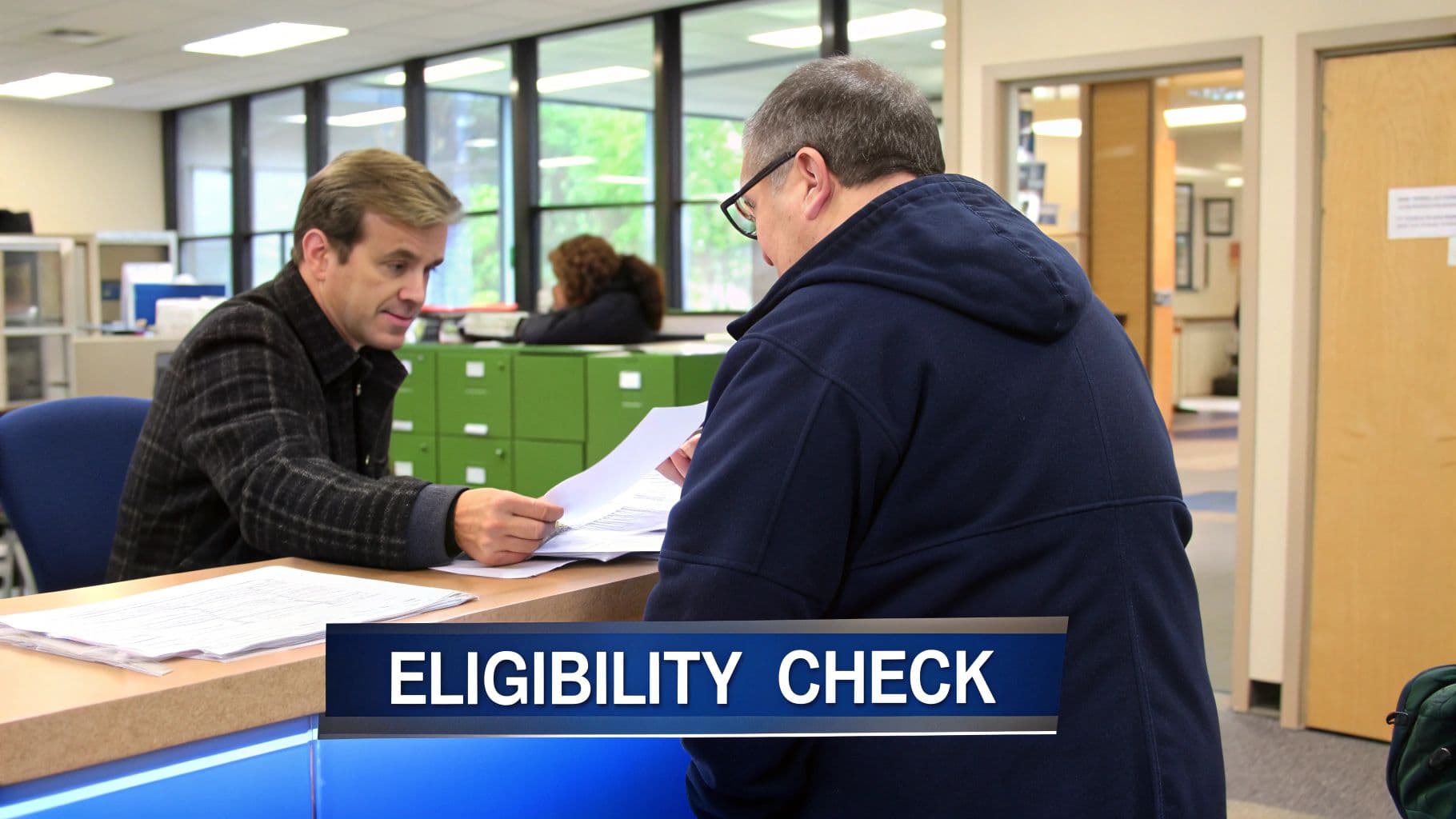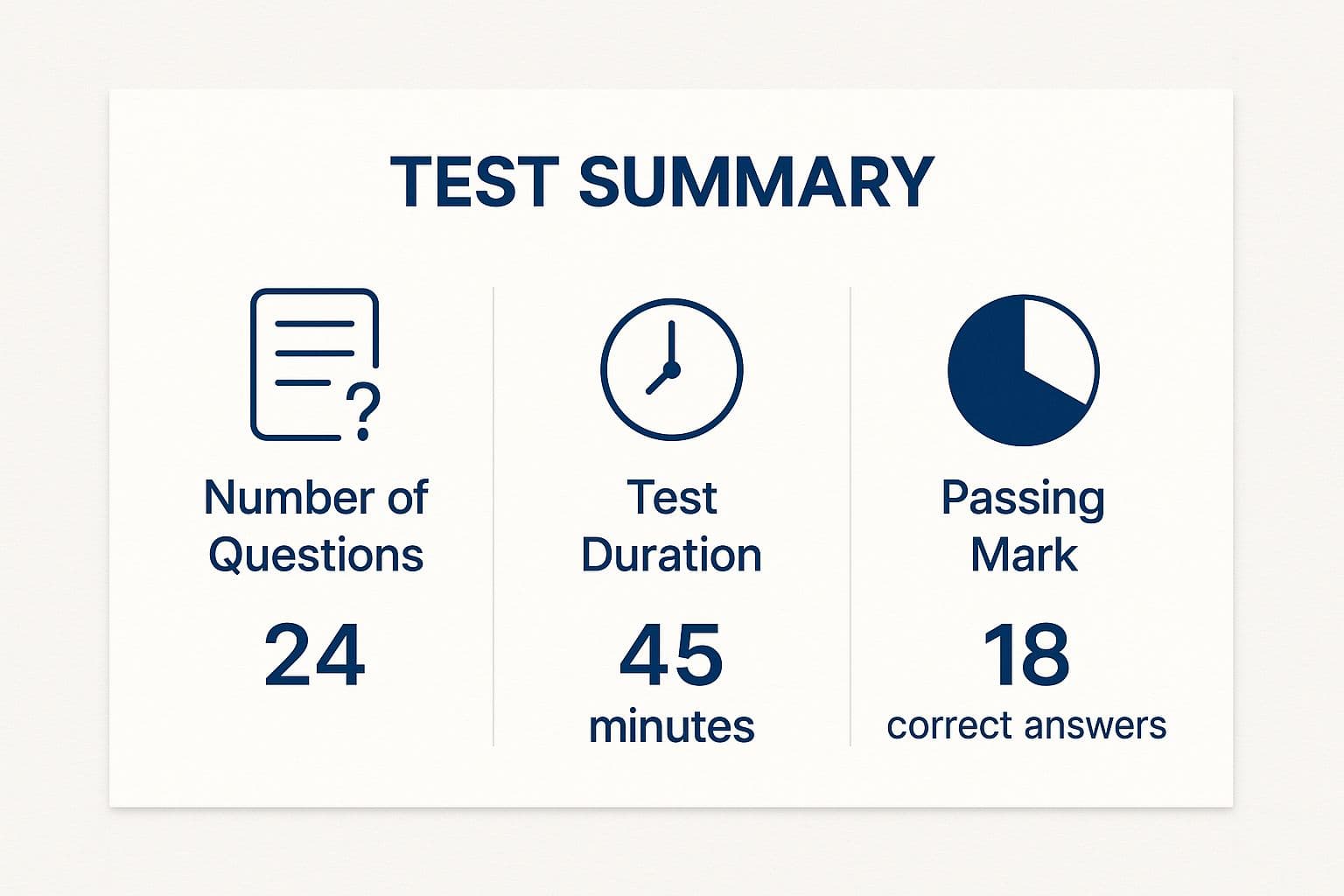Ace the Life in the UK Test with Proven Strategies

Understanding the Life in the UK Test: Beyond the Basics
The Life in the UK Test is a crucial step for those seeking Indefinite Leave to Remain or British citizenship. It's not simply a box to tick, but a way to understand the essence of British society. This goes beyond rote memorization of facts and figures. It requires understanding the context and significance of these facts within the larger historical and cultural framework.
The test assesses an applicant's knowledge of British history, traditions, customs, and political systems. It ensures those wishing to make the UK their home possess a basic understanding of the country's values and way of life. For a good overview of the test's purpose, take a look at this article: What is the Life in the UK Test?. This foundational knowledge is essential for integrating and actively participating in the community.
The Life in the UK Test has been a requirement since 2005 for citizenship and 2007 for Indefinite Leave to Remain. The test comprises 24 questions drawn from the Life in the United Kingdom: A Guide for New Residents handbook. A significant number of tests were administered between 2010 and 2014, totaling 748,613. This reflects the high volume of individuals aspiring to become part of British society. More comprehensive statistics can be found here: Life in the United Kingdom test. This substantial number emphasizes the test's importance within the UK immigration system.
Key Differences: Settlement vs. Citizenship
The test itself is consistent across both applications, yet the ramifications of taking it vary depending on the individual's goals. For settlement (Indefinite Leave to Remain), passing the test is one requirement amongst several. However, for citizenship applications, the test carries greater significance, demonstrating a commitment to British life and its values.
Test Format and Conditions: What to Expect
Preparation hinges on a good grasp of the test's structure. The test is conducted at an approved test centre. You'll have 45 minutes to answer 24 multiple-choice questions. A 75% score, or 18 correct answers, is needed to pass. The digital format provides immediate results, eliminating any waiting period. This instant feedback offers both relief and valuable insights for future planning.
To help you understand the test structure, the following table summarizes key information:
Life in the UK Test at a Glance: Key information about the test format and requirements
Test Element | Details |
|---|---|
Number of Questions | 24 |
Question Type | Multiple-choice |
Time Limit | 45 minutes |
Passing Score | 75% (18 out of 24 correct answers) |
Format | Digital |
Result Delivery | Immediate |
Source Material | Life in the United Kingdom: A Guide for New Residents |
This table highlights the core elements of the Life in the UK Test, emphasizing its structured format and the importance of thorough preparation using the official handbook.
Study Materials That Actually Work (And Those to Avoid)
Choosing the right study materials for the Life in the UK Test is essential for effective preparation. With so many resources available, it can be difficult to know where to start. This section, drawing on advice from successful test-takers, will help you navigate the options and find the best materials for your learning style.
The Official Handbook: More Than Just Memorization
The Life in the United Kingdom: A Guide for New Residents handbook is the cornerstone of your preparation. However, simply reading it isn't enough. Successful applicants recommend engaging with the material actively, moving beyond memorization to deeper understanding. This might involve creating timelines, building mind maps, or using visual aids to connect with historical facts and figures. This approach makes learning more enjoyable and effective.
Supplementing the handbook with other reliable resources is also beneficial. Practice tests and online quizzes are highly recommended by those who have passed the test. These tools allow you to assess your knowledge, identify areas for improvement, and reinforce your understanding. The Life in the UK Test is widely taken, with 119,287 individuals sitting for it between April 2013 and March 2014. This represents a portion of the over 616,950 naturalization applications since 2013, many of whom likely also took the test. For more detailed statistics, see this article: What does the Life in the UK handbook say about who the ‘British people’ are?. Given the importance of this test, selecting the right study materials is crucial.

Tailored Study Strategies for Different Learning Styles
Understanding your learning style is key to choosing the right study methods. Visual learners might find documentaries or illustrated guides helpful. Auditory learners could benefit from podcasts or audiobooks. Kinesthetic learners often thrive with interactive activities and practice quizzes. The Life in the UK Test App is a good example of a resource that caters to various learning styles with its diverse question formats and interactive features.
Hidden Gems and Budget-Friendly Alternatives
While some paid resources can be helpful, plenty of free and affordable options are just as effective. Your local library and community center are excellent places to find valuable resources and support. Online forums can also be a great source of information and community. These often-overlooked resources offer a budget-friendly way to enhance your preparation.
Recommended Study Materials: A Quick Guide
Here are some helpful resources to consider:
Official Handbook: The essential starting point for your preparation.
Life in the UK Test App: Provides comprehensive practice questions, mock tests, and personalized feedback.
Online Practice Tests: Help reinforce your knowledge and pinpoint areas needing more attention.
Documentaries and Podcasts: Offer engaging ways to learn about British life and history.
Local Libraries and Community Centres: Provide access to free study materials and support.
Materials to Avoid: Common Pitfalls
Some materials can actually hinder your progress. Outdated practice tests, unreliable online quizzes, or overly simplified summaries can misrepresent the real test content. This can result in inadequate preparation and reduce your chances of success. Stick to reputable and current resources to maximize your study time and improve your odds of passing the test on your first try. Choosing the right materials will ensure you are well-prepared and confident on test day.
Breaking Through the Toughest Test Obstacles
This infographic provides a clear overview of the Life in the UK test format: the number of questions, test duration, and the required passing mark.

With only 45 minutes to answer 24 questions and achieve a 75% pass rate (18 correct answers), effective preparation is crucial. This means focused study and strategic use of practice resources are key to succeeding on the Life in the UK test. Let's delve into common challenges and proven strategies to overcome them.
Conquering British Monarchs and Key Dates
Many find memorizing British monarchs and historical dates daunting. Traditional rote learning often proves ineffective.
Instead, try creating a timeline, visualizing the sequence of reigns and connecting them to significant events. This approach transforms memorization into understanding.
For example, associating a monarch with a particular war or social change creates a more memorable narrative. Mnemonic devices or rhymes can further aid retention and recall.
Navigating the Nuances of the English Language
Non-native English speakers often face unique challenges with the Life in the UK test. Vocabulary and comprehension can be particularly tricky under test conditions.
Focus on building vocabulary specific to British culture and history. This targeted approach is more effective than studying general English vocabulary. It allows for improved comprehension of test-relevant materials.
Regular practice with authentic test materials is essential. Resources like the Life in the UK Test App can enhance language skills and build confidence. Familiarity with the style and phrasing of the test questions is key.
However, some individuals struggle significantly. One migrant took the Life in the UK test a record 118 times in just two years, highlighting the test's difficulty. More detailed statistics can be found here. This reinforces the need for targeted and effective preparation.
Decoding Tricky Question Phrasing
The phrasing of questions on the Life in the UK test can be confusing. Small wording changes can significantly alter the meaning and the correct answer.
Practice is crucial to mastering this challenge. Carefully analyze practice questions, paying close attention to keywords and qualifiers. This approach develops a deeper understanding of question structure.
Think of it as deciphering a puzzle. Each word plays a crucial role in guiding you to the correct solution. Recognizing the difference between words like "mostly" and "always" can be crucial for selecting the correct answer.
The following table summarizes the challenges and recommended strategies discussed:
Challenging Test Topics vs. Effective Study Strategies
Challenging Topic | Why It's Difficult | Recommended Strategy |
|---|---|---|
British Monarchs and Key Dates | Difficulty memorizing large amounts of information | Create timelines, use mnemonics and associate with events |
English Language Nuances | Vocabulary and comprehension challenges for non-native speakers | Focus on test-specific vocabulary and practice with authentic materials |
Tricky Question Phrasing | Subtle wording changes significantly impact meaning | Analyze practice questions and pay close attention to keywords |
This table summarizes key test challenges and provides practical solutions for effective preparation. By understanding these difficulties and implementing the suggested strategies, test-takers can significantly improve their chances of success on the Life in the UK test.
Mastering Practice Tests: Beyond Repetition

Practice tests are invaluable tools for preparing for the Life in the UK Test. However, simply repeating them without a strategic approach won't guarantee success. This section explores how to use practice tests effectively to maximize learning and build confidence. Think of these tests not as a measure of what you already know, but as a way to discover what you still need to learn.
Analyzing Practice Results: Identifying Weaknesses
Reviewing incorrect answers is arguably more important than celebrating correct ones. Don't just memorize the right answer; strive to understand why it's correct. For example, if questions about British monarchs consistently trip you up, avoid simply rereading the relevant section of the handbook. Instead, try creating a timeline to visualize the monarchs' reigns and connect them to significant historical events. This type of active learning helps solidify the information in your memory.
Also, analyze patterns in your mistakes. Are you struggling with specific subjects, particular question formats, or managing the allotted time? Identifying these patterns allows you to focus your study efforts where they are most needed.
Timing and Frequency: The Science of Retention
The timing and frequency of your practice sessions play a crucial role in knowledge retention. Cramming the night before the test is far less effective than spaced repetition. This technique involves reviewing material at increasing intervals. It leverages the spacing effect, a cognitive principle that enhances long-term retention.
For example, review a topic the day after learning it, then again a few days later, and finally the following week. This reinforces knowledge over time, making it more likely to stick. Spaced practice strengthens recall much more effectively than last-minute cramming.
Recreating Test Conditions: Managing Exam Pressure
Your practice tests should closely mimic the actual exam environment. Use a timer, minimize distractions, and adhere to the 45-minute time limit. This helps you acclimate to the pressure of the real test. It's not just about knowing the material; it's also about performing under pressure.
This preparation extends beyond simply acquiring knowledge; it addresses the psychological aspects of the exam. Consider it a dress rehearsal. The more you practice under realistic conditions, the more confident and prepared you'll be on test day. This involves finding a quiet space, using the official handbook, and timing yourself precisely as you would during the actual test.
Tracking Progress and Adapting Your Approach
Monitor your scores on practice tests, but don't be discouraged by occasional setbacks. Use your performance to refine your study plan. If you consistently struggle with a particular area, dedicate more time to it. The Life in the UK Test App with its Hard Mode and Readiness Score provides excellent tools for personalized practice and progress tracking.
This allows you to adapt your study strategy as needed. Think of it as a feedback loop: practice, analyze, adjust, and repeat. This continuous improvement cycle helps fine-tune your preparation and maximizes your chances of success. By using these strategies, you transform practice tests from mere assessments into powerful learning opportunities. They systematically improve performance and build confidence for the big day.
Test Day Navigation: From Booking to Results

The Life in the UK Test is challenging, but navigating the logistics of test day can be just as stressful. This guide walks you through the entire process, from booking your test to receiving your results, offering practical advice along the way.
Booking Your Test: Securing Your Preferred Slot
Booking your Life in the UK test involves choosing a convenient test centre and time slot. Many centres may appear fully booked, but don't give up. Regularly check for cancellations, as slots often become available unexpectedly.
Consider less popular times, such as weekday mornings or evenings. These slots often have more availability than weekend afternoons. This flexibility can greatly improve your chances of getting a time that works for you.
Essential Documentation: Beyond the Basics
Be sure to have the correct identification documents, as outlined in the official guidelines. It's also a good idea to bring additional proof of address or identity, like a recent utility bill. This extra documentation can be helpful if there's a problem with your primary ID.
While digital confirmation is usually enough, a printed copy of your booking confirmation is also recommended. A physical backup can avoid issues if you experience any technical difficulties.
Test Centre Etiquette: Avoiding Red Flags
Test centres have strict rules. Arriving late, using your phone, or talking to other candidates can lead to disqualification. Test centre staff actively enforce these rules.
Treat the test environment like a formal exam. This respectful approach ensures a smooth and uninterrupted test experience.
Handling Unexpected Scenarios: Technical Glitches and Check-in Complications
Although rare, technical problems can happen. Stay calm and notify the staff right away. They are trained to handle these situations and will work to resolve the problem quickly.
Similarly, if there's a problem with checking in, calmly explain the situation and provide any supporting documentation. Clear communication and a calm demeanor can resolve most check-in issues.
Understanding Your Results: What to Expect
You'll receive your results on-screen immediately after finishing the test, clearly showing whether you passed or failed. If you pass, you'll receive a pass notification letter, essential for your citizenship or settlement application. Keep this document safe.
Make a copy for your records and store the original securely. This protects this vital document and ensures you can access it when needed.
This guide helps you prepare for all aspects of test day, from booking to receiving your results. By being ready for potential challenges, you can confidently navigate the process. Understanding the procedures, documentation, and potential issues minimizes stress and allows you to focus on performing your best on the test.
From Test Success to Citizenship: Completing Your Journey
Passing the Life in the UK Test is a major milestone. However, it's just one step on the path to UK citizenship or settlement. This section offers guidance on the process, from a successful test result to achieving your ultimate goal. We'll incorporate insights from immigration experts and individuals who have successfully completed this journey.
Beyond the Test: Additional Requirements
The Life in the UK Test is essential, but it’s not the only requirement. You'll also need to demonstrate English language proficiency and provide documentation of continuous residence. For more information on the overall citizenship application process, see this helpful article: How to get UK citizenship. English language requirements vary depending on your individual circumstances, so it's essential to verify the specifics for your application type. Gathering the necessary residence documentation early on can save you time and stress. This typically includes proof of your address history, employment records, and documentation of any travel outside the UK.
Referencing Your Test Certificate: Avoiding Common Errors
When applying for citizenship or settlement, accurately referencing your Life in the UK Test pass certificate is crucial. This means providing the correct certificate number and test date. Thousands of applications are delayed annually due to errors in this section. Double-checking all the details against your certificate is vital to ensure accuracy. Treat it like a critical form – any mistakes could cause delays or even lead to rejection.
Application Timelines and Tracking
Processing times for citizenship and settlement applications can vary. Understanding the expected timeframe for your application type helps manage expectations. Learning how to track your application's progress is equally important. The Home Office provides online tools and resources for this. Regularly checking the status keeps you informed and allows you to address any potential issues quickly.
Contingency Planning: Handling Potential Complications
Even with thorough preparation, unexpected issues can occur. A document might be misplaced, or processing delays could arise. Having a contingency plan in place can help you manage these challenges. This might involve keeping digital copies of all your important documents and understanding who to contact if you encounter problems.
Your Roadmap to Citizenship: A Step-by-Step Guide
Here’s a simplified roadmap to visualize the process:
Step 1: Pass the Life in the UK Test and secure your pass notification letter.
Step 2: Gather all required documents, including proof of English language proficiency and continuous residence documentation.
Step 3: Complete your citizenship or settlement application form accurately, referencing your test certificate correctly.
Step 4: Submit your application and pay the associated fee.
Step 5: Track your application’s progress regularly.
Step 6: Prepare for your citizenship ceremony (if applicable).
This roadmap simplifies the journey and highlights the importance of each stage, guiding you from test success to citizenship or settlement.
Successfully navigating the path to UK citizenship or settlement requires careful planning and attention to detail. By understanding the process, gathering the correct documentation, and preparing for potential challenges, you can ensure a smoother, more efficient experience.
Ready to begin preparing for the Life in the UK Test? The Life in the UK Test App offers a comprehensive and convenient study solution. Download the app today at https://lifeintheuktestapp.co.uk and take the first step towards your UK citizenship or settlement goals.